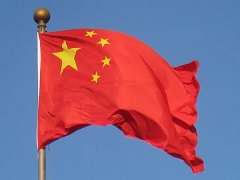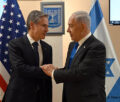High-Profile Visits Aid Beijing Propaganda, Experts Say

Dubbing House Speaker Nancy Pelosi “a selfish child” whose visit to Taiwan was destined to be “torn up by history,” China’s state media generated dozens of articles on a U.S. politician who has been criticizing Beijing for more than 30 years.
Coverage of the early August visit by Pelosi to Taiwan underscores how Chinese state media reflect Beijing’s worldview on everything from the independence of disputed regions to human rights abuses.
From domestic trips by Chinese Communist Party (CCP) heads to visits by international leaders, each official visit brings its own level of uncertainty and propaganda value for Beijing, say academics who specialize in Chinese media.
But visits that generate attention from foreign media and governments are likely viewed by Beijing as an opportunity to shape the narrative around core issues, said Jonathan Hassid, a professor specializing in Chinese news media at Iowa State University.
“They can be very powerful propaganda vehicles,” he told VOA.
State media reporting can seek to glorify or legitimize the CCP and Xi Jinping, as well as counter more critical reporting by foreign media, Hassid and other experts said.
A U.S.-based professor who specializes in Chinese propaganda said that visits by foreign leaders — like Pelosi’s — carry a high degree of uncertainty for Beijing.
But they also provide a relatively high propaganda value because, with the added attention, “the propaganda value of those trips is actually higher than tightly choreographed trips in Xinjiang and Hong Kong,” she said.
The academic, who is based on the East Coast of the United States, requested anonymity due to safety concerns for herself and family in China.
On some domestic trips by CCP officials, Beijing allows restricted access to its own media, but even that is “highly orchestrated and controlled,” an employee for a Chinese state-run outlet said.
The editor, who is based in China, spoke on condition of anonymity due to safety concerns.
“You can only report the government’s position on the matter in these cases,” she wrote in a message to VOA. “It’s particularly significant as it affects the government’s reputation on the global stage.”
The Chinese embassy in Washington did not respond to VOA’s email requesting comment.
‘Between the lines’
China’s 20th National Congress is scheduled to be held in coming months, with Xi expected to secure a third term.
His trips to Xinjiang in July and Hong Kong in June served to send a message to the country’s political elites, according to the anonymous professor.
“Doing these trips is a way to affirm his power — sort of a victory lap to show how effective he has been as the national leader in these regions,” she told VOA.
The state media employee agreed. “[My outlet] wants to portray a good and grand image of Xi in its coverage, which definitely came through as state outlets are only allowed to report the official line,” she told VOA.
Visits to Xinjiang by Xi and separately by the United Nations High Commissioner for Human Rights Michelle Bachelet showed not only the way China’s state media push a certain narrative of normalcy in Xinjiang, but also how Beijing tightly controls access for foreign journalists.
Foreign journalists learned of Xi’s visit — his first to the region in eight years — by reading reports in Chinese media, which focused on minute details of Xi’s visit.
Missing from the state coverage of Xi’s trip was any criticism of China’s policies and mass incarceration of Uyghurs in Xinjiang — also known as East Turkestan — that several governments and civil society groups say likely amounts to genocide.
The visits may be out of bounds to Western journalists, but the state media coverage is still useful, as long as you know how to read between the lines, said Chris Buckley, chief China correspondent for the New York Times, in an interview with VOA.
“Our role as foreign journalists really comes down to reading the official summaries from these visits and reading them for what signals they send about policy,” said Buckley, who is based in Sydney, Australia.
“These trips are explained very carefully, controlled, and even contrived as political theater. Particularly the way in which they’re presented in Chinese media is meant to send certain signals and messages about the direction of policy,” Buckley said.
The different approaches by China’s state and Western media came to the fore at a press conference near the close of Bechelet’s travels to China in May, the first visit to the region by a U.N. human rights chief since 2005.
Journalists were not present for the trip — a move the U.N. human rights office says enables the high commissioner to have frank and open conversations with the people she meets. But a spokesperson noted that she tries to compensate by holding a news conference, as she did in China.
Journalists from The Guardian and CNN asked about Bachelet’s access in Xinjiang and her long-anticipated report on human rights abuses in the region. Representatives from outlets including the People’s Daily asked Bachelet to compare the “real Xinjiang” to Western media depictions or asked questions about gun violence in the U.S.
The state media employee who spoke with VOA said state outlets “reported the official government line, which is that the U.S. is always smearing China and that it is always trying to find something to bring China down.”
Beijing has increasingly emphasized the importance of “telling China’s story well” to the rest of the world, and trips like Bachelet’s help that campaign, Kingsley Edney, a professor at Britain’s University of Leeds, told VOA.
Hassid shared a similar view, but said the trips are rooted in historic symbolism.
“It’s hard not to see her visit as anything except giving the Chinese government what it wants, which is a stamp of approval, that Xinjiang is okay,” Hassid told VOA. “It is the gold standard for the Chinese government to have foreigners show up and pat them on the back.”
Official visits carry a special historical and cultural significance in China, with emperors using them to exercise authority, according to Hassid.
Even today, the “symbolism of it all” is demonstrated by state media coverage, he said.
—VOA
-
Book Shelf
-
 Book Review
DESTINY OF A DYSFUNCTIONAL NUCLEAR STATE
Book Review
DESTINY OF A DYSFUNCTIONAL NUCLEAR STATE
- Book ReviewChina FO Presser Where is the fountainhead of jihad?
- Book ReviewNews Pak Syndrome bedevils Indo-Bangla ties
- Book Review Understanding Vedic Equality….: Book Review
- Book Review Buddhism Made Easy: Book Review
- Book ReviewNews Elegant Summary Of Krishnamurti’s teachings
- Book Review Review: Perspectives: The Timeless Way of Wisdom
- Book ReviewNews Rituals too a world of Rhythm
- Book Review Marx After Marxism
- Book Review John Updike’s Terrorist – a review
-
-
Recent Top Post
-
 Commentaries
Impasse over BRI Projects in Nepal
Commentaries
Impasse over BRI Projects in Nepal
-
 CommentariesNews
Yet another Musical Chairs in Kathmandu
CommentariesNews
Yet another Musical Chairs in Kathmandu
-
 CommentariesTop Story
Spurt in Anti-India Activities in Canada
CommentariesTop Story
Spurt in Anti-India Activities in Canada
-
 NewsTop Story
Nepal: Political Stability Under Threat Again
NewsTop Story
Nepal: Political Stability Under Threat Again
-
 NewsTop Story
Accountability Tryst With 2024 Ballot….
NewsTop Story
Accountability Tryst With 2024 Ballot….
-
 NewsTop Story
What Would “Total Victory” Mean in Gaza?
NewsTop Story
What Would “Total Victory” Mean in Gaza?
-
 CommentariesTop Story
The Occupation of Territory in War
CommentariesTop Story
The Occupation of Territory in War
-
 CommentariesTop Story
Pakistan: Infighting in ruling elite intensifies following shock election result
CommentariesTop Story
Pakistan: Infighting in ruling elite intensifies following shock election result
-
 CommentariesTop Story
Proforma Polls in Pakistan Today
CommentariesTop Story
Proforma Polls in Pakistan Today
-
 CommentariesTop Story
Global South Dithering Away from BRI
CommentariesTop Story
Global South Dithering Away from BRI
-
AdSense code



















